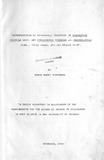| dc.description.abstract | Occurrence and extent of pathogenic variation
and virulence was determined in Isariopsis griseola
Sacco and Pseudomonas syringae pv. phaseolicola
(Burk. 1926) Young, Dye and Wilkie 1978 using 21 and
30 isolates respectively, collected from naturally
infected bean plants in important bean growing areas
of Colombia.
. griseola did not show any correlation
between variation in conidial size and some cultural
characteristics with the observed variation in
pathogenicity. Conidial length of 10 isolates
varied between 18-76~ with a mean of 38.5~. The
width varied between 3.8 - 8.8~ with an average
of 6.4~, whereas the number of septa varied between
0-7 with a mean of 3. These parameters varied
significantly both within and between isolates.
The optimum growth temperature of the fungus
in culture media was 24 C. No difference in the
amount of mycelial growth at 14, 19, and 24 C was
observed between the isolates. Differences in
sporulation among some isolates were significant but
all except IG2 - 78 had an optimum sporulation
temperature of 24 C after 10 days of incubation.
IG2 - 78 produced significantly more conidia at
19 C than at 24 C. No correlation between the
optimum growth and sporulation temperature of the
isolates with the mean temperatures of their
sources of origin was observed.
The 21 isolates of griseola were
differentiated into seven pathotypes based on
differential reactions of 6 bean lines/cultivars,
demonstrating occurrence of physiological
specialization in the fungus. The reactions used,
were independent of environmental temperatures
under which plants were kept after inoculation.
The cultivar - isolate interactions obtained implied
a presence in the cultivar of specific resistance
which was effective against some and not all the
pathotypes. Cultivar G 2575-10P-2C was susceptible
to all but no cultivar was immune to all pathotypes.
Two out of the seven pathotypes induced a
susceptible reaction on cultivar G 1805-lP-lC but
of very low (disease index scale of 2) disease
severity. Some of the cultivars considered susceptible
appeared to have partial resistance, expressed as
reduced, apparent infection rate (r) of angular
leaf spot in the field.
The isolates of Ps. syringae pv. phaseolicola
were separated into race 1 and 2 on the basis of
their pathogenicity on the cultivar 'Red Mexican
DI 3'. Race determination was based on both leaf
and pod reactions. Standard isolates of race 1 and
2 were used for comparison. Twenty Pasto isolates
were classified as race 2 whereas, 7 isolates from
Popayan, 1 from Palmira and 2 from Tenerife were
identified as race 1.
The isolates were also classified in their
decreasing order of virulence by using the diameters
of watersoaking lesions caused on pods during a
period of 5 days on cultivars 'Seminole', 'G.N.
Nebraska No.1 Sel 27' and 'Wisc HBR 72'; following
inoculation using a hypodermic needle. The most
virulent isolates were from Pasto; some of which
were more virulent than the standard race 2 used for
comparison. Isolates differentiated into race 1 and
2 were not homogenous in virulence. Some isolates
belonging to race 1 were more virulent than some of
the race 2 isolates or vice versa .apparently,
due to either isolate and/or cultivar effect.
Cultivar 'Wisc. HBR 72' had a high foliar
resistance but a susceptible pod reaction (mean
lesion diameter 3.1 rom; dispersion 0.5 ~ 5.3 rom)
comparable to the susceptible cultivar 'Seminole'
(mean lesion diameter 2.8 rom; .dispersion 0.5 - 4.8 rom).
'G.N. Nebraska No. 1 Sel 27' had a mean lesion
diameter of 1.8 rom and a dispersion between 0.4 -
2.8 rom. The increasing or decreasing order of
virulence was similar in all the three cultivars as
was indicated by the high correlation coefficients
(r = 0.86 - 0.87) between them.
The present studies unequivocally show that
both bean pathogens exhibit pathogenic variation.
A high degree of cultivar - isolate specificity was
observed with I. griseola. Specificity was also
shown with isolates of Ps syringae pv. phaseolicola
when using 'Red Mexican UI 3'. However, virulence
of the bacterial isolates varied continuously in
a manner which nullify the present race categorization.
The practical importance of these findings
are that they provide basic information about the
pathogens ,that must be considered before starting a
program to either incorporate or develop resistance
against angular leaf spot and halo blight in
P. vulgaris. The presence in some bean cultivars
of pathotype specific resistance and in others partial
resistance characterized by reduced rates of disease
increase, indicate the available possibilities of
recombining resistance aqainst; 1 griseola. To grade
pathogenicity and virulence of isolates of Ps. syringae
pv aseolicola, leaf and pod reactions of various
bean cultivars, and not just one, must be based on.
In turn, evaluation and improvement of resistance of
bean cultivars against the bacterium should consider
both the leaf and pod components of the plant. | en |

